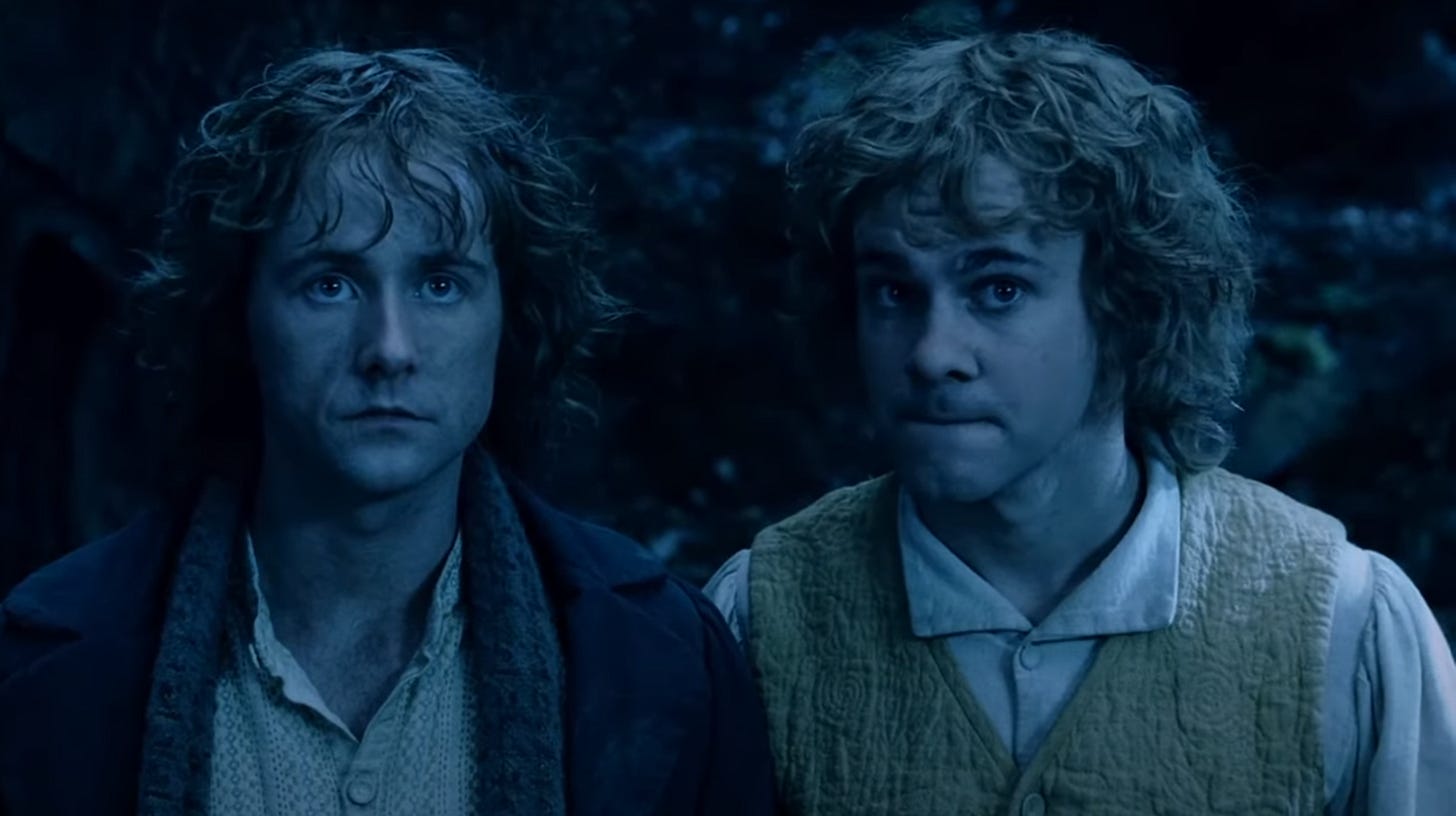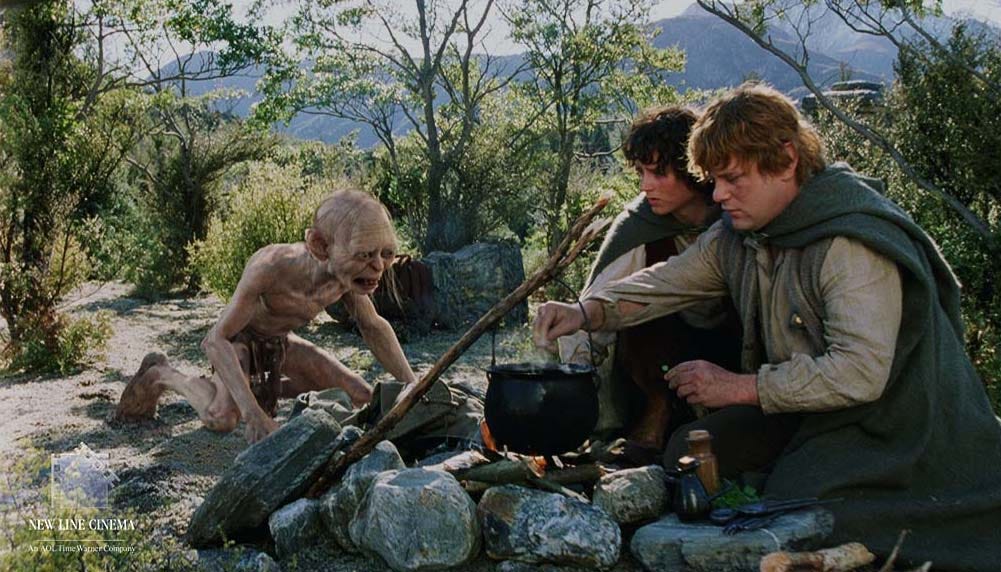I don’t like Gollum.
When Samwise’s first instinct is to kick that nasty freak in the head, I whisper; Correct. My finger itches over the fast-forward button whenever his translucent form shuffles onto the screen. I understand his purpose within Frodo’s story. I see how he represents the dreadful weight of The Ring. I appreciate how important he is technologically.
Yet still, I think of @hellocullen’s immortal tweet:
It’s a shame because even though I would like to kill Gollum with a hammer, he represents what The Lord of the Rings: The Two Towers is sorely lacking: strangeness.
The Two Towers picks up shortly after the exhilarating ending of Fellowship. The Fellowship is broken—Frodo and Sam (Elijah Wood and Sean Astin) chart their course toward Mordor, Merry and Pippin (Dominic Monaghan and Billy Boyd) have been captured by marauding orcs, while Aragorn, Legolas, and Gimli (Viggo Mortensen, Orlando Bloom, and John Rhys-Davies) find themselves in the war-torn realm of Rohan. Towers is a sprawling and heady epic—a tonal far cry from the comparatively weird little horror film that Fellowship was. With a larger focus on Aragorn’s journey toward leading the kingdoms of Man, Towers leans full-bore into being a war movie—a narrative and stylistic choice that flavors the entire trilogy within the cultural memory. With all the talk of extended cut marathons, it’s surprising how little the vibe shift between Fellowship and Towers is discussed. Watching them back to back is fairly jarring—like leaping from Evil Dead to Macbeth.
It’s hard to feign total surprise though, as this shift was baked into the source material from the beginning. Epic poetry like Beowulf and the Kalevala were as large of influences on Tolkein’s Middle Earth as the proper Brexit Geezers of the English countryside. With Aragorn’s story at the forefront, Jackson ditches the canted angles and Looney Tunes action of Fellowship in favor of the stoic filmmaking of a historical epic. Gone are the yelps of “You've been into Farmer Maggot's crop!” replaced with “Alas, that these evil days should be mine.”
Now, you’ll never catch me bad-mouthing the great nation of Rohan. I’m a mark for “horse lord” cultures in fantasy, and the late great Bernard Hill provides the series’ most poignant performance as Théoden, king of Rohan. Whether he is drowning in old age makeup and cosplaying as Biden or a hot-blooded warrior king awakened to his people’s plight, Hill delivers archaic lines with a ferocity that is still unmatched in genre filmmaking. As he stumbles down the steps of Edoras, sword in hand, towering above Gríma Wormtongue (Brad Dourif), Théoden bellows down with righteous anger “Your leechcraft would have me crawling on all fours like a beast!” It’s my favorite line in the film.
So believe me when I say that I love this stuff. However, the focus on human affairs sets a rather mannered tone. As I mentioned before, this is a historical war epic, akin to Kingdom of Heaven or Master and Commander. It’s silly to bemoan the lack of fantasy elements while talking trees (more on them later) and orcs march upon the realm, but even within the Rohan story, the orcs largely fill the classic trope of “barbarian” hordes.1 There is a broad-chestedness to the filmmaking—a machismo in place of whimsy. Thankfully it never veers into toxic masculinity—but in these stretches, I’d find myself zoning out as sword fights became standard or when another character explained who the Dúnedain were. All that said—when it works, it works. Like the legendary battle of Helm’s Deep. I won’t delve deep (heh) into why it’s so good—but for me, the mud, orc blood, and clearly established action-geography provide a tangibility that’s missing from a film that sometimes feels like a Neoclassical painting of some mythological text.
With the Fellowship fractured, the film relies on Aragorn’s arc in Rohan to provide the narrative propulsion that the Fellowship’s united march toward Mordor did in the first entry. Instead of one larger quest, Towers splits the party and asks each character, “What are you fighting for?” Aragorn and Théoden verbalize their reasons for fighting as the orcs crash against their doors. “For death and glory,” Théoden says, with a wild glint in his eyes. “For your people,” says Aragorn, a king in the making. Even Saruman (Christopher Lee) is allowed his chance to state his intentions—proselytizing the age of the orc and “the fires of industry.” Lee is able to make a meal out of scenes both big and small, bringing the thunder while murmuring about Aragorn’s secret ring or screaming a call to war over legions of orcs. Outside the dark tower of Orthanc, within the wild woods of Fangorn Forest, Merry and Pippin come to their reason for fighting by helping the Ents find their own. While they spend most of the film riding atop Treebeard’s (John Rhys-Davies) shoulders, theirs is my favorite section of the sequel. Perhaps the two with the least stakes in the great adventure, Merry and Pippin are allowed to evolve from a comedic duo to multifaceted characters who fight because, as Merry tells Treebeard, “You’re part of this world.” In a sequence that melds the sorrowful atmosphere of Towers into a triumphant battlecry for fantasy, the Last March of the Ents is my Helm’s Deep. With inventive creature design, an all-timer score, and expert model-work—it’s a scene that shakes the soul.
It also helps that Pippin looks incredibly hot during all the nighttime scenes moonlit in the woods.
Finally, we must talk about Gollum…along with Frodo and Sam.
In my longing for more fantastical elements within the filmmaking and the narrative, I was most disappointed with this trio’s story. Yes, they’re dirty as hell. Yes, they venture through some of the best environments within the series (shout out the Dead Marshes2). But it is with them that the oft-celebrated extended edition runtime began to feel excruciating. Maybe it’s because after so many repeated viewings, watching Frodo fall for Gollum is like watching a horror movie character go into a basement: Don’t fucking do it. As I said before, Gollum represents a historic leap in animation and performance capture (I wouldn’t have my beloved Planet of the Apes movies without it), but his role often borders dangerously close to Jar Jar Binks territory. I want to enjoy the levity he brings, but slurping down worms like spaghetti and sliding across the ground like a Snapchat filter doesn’t do it.
As for Frodo and Sam, their scenes often feel the most uneven among the Fellowship—with every engaging moment countered by an inert one. The greats (hiding from the winged Nazgûl, their pleas to Faramir [David Wenham]) are always countered by the bad (Sam’s plan to just run through the Black Gates, Sam and Frodo arguing about Gollum again). Only at the end of their journey, within the fallen city of Osgiliath, are they given a truly successful scene. In a war movie filled with swinging swords and chest-beating speeches, Sam’s pained delivery on the final monologue is most stirring—that “there's some good in this world, Mr. Frodo, and it's worth fighting for.”
It’s a shame then, after such a beautiful moment, Towers ends on what boils down to the MCU’s final teaser sentences:
Gollum will return in Return of the King.
The Lord of the Rings: The Two Towers is streaming on HBO MAX and is available to rent on most streaming platforms.
Special thanks to Austin Smoldt-Sáenz, Elena Bruess, Joshua De Lanoit, and Max Seifert.
The Easterlings definitely fit the racist stereotype of “Arab baddies”, which pairs uncomfortably with the sadly common right-wing reading of “Men of the West.” Faramir at least gives them a sense of humanity with his “War will make corpses of us all” monologue. Otherwise, for a series with near-perfect design, the Easterling armor looks pretty awful.








